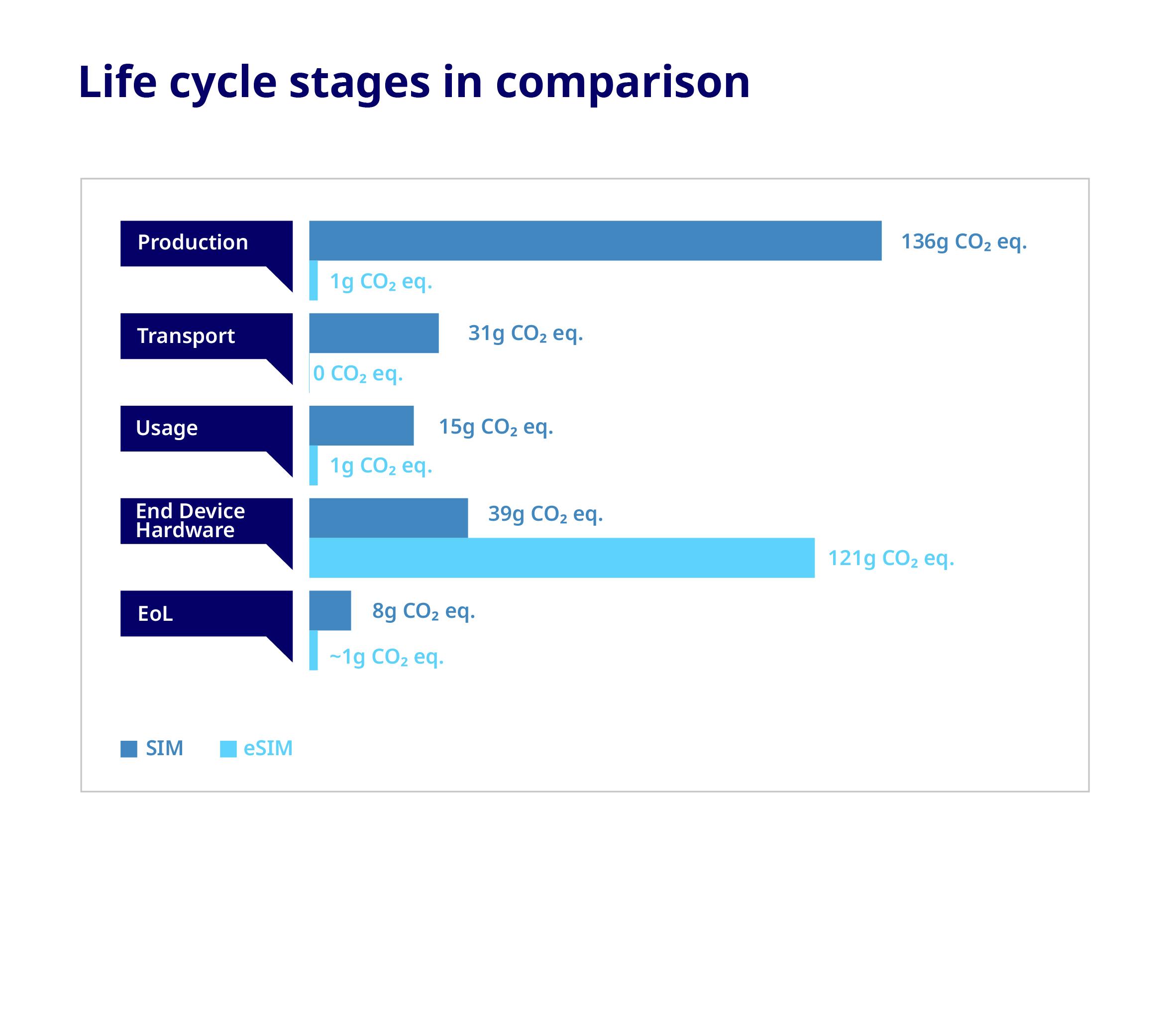Independent study by Fraunhofer IZM for G+D confirms eSIM as an environmentally friendly SIM solution
Munich, 28 November 2022 – An independent comparative life cycle assessment (LCA) of SIM card and eSIM balances conducted by Fraunhofer IZM demonstrates a clear lead for the embedded SIM (eSIM) in terms of environmental compatibility. This confirms the merits of Giesecke+Devrient‘s (G+D) eSIM strategy, which is focusing on the further development of this environmentally friendly technology.
The results of the life cycle assessment confirm the eSIM as the more environmentally friendly solution in all analyzed environmental impact categories compared to the SIM card. Particularly noteworthy are the lower CO2 emissions. The LCA of the two formats shows a 46 percent reduction in emissions for the eSIM in comparison with the SIM card (123g CO2 equivalent versus 229g CO2 equivalent). The differences are even more pronounced at the various stages of the life cycle: for the SIM card, 59 percent of emissions occur during production (upstream), while transport and use (downstream) account for 41 percent. In the case of the eSIM, on the other hand, only two percent of emissions occur during production. The remaining 98 percent are due to downstream, as the eSIM chip is installed in the mobile device by the original equipment manufacturer (OEM).
The LCA was carried out by G+D and Fraunhofer IZM, specialists in applied and industrial contract research, in accordance with ISO standard 14040/14044 and was accompanied by an external review panel. The results were subsequently confirmed by a review statement. The setup of the study tested the environmental impact of one (1) SIM card and one (1) eSIM when authenticating a (1) single user in the mobile network, including use of the functionality for a period of three years. This corresponds to the typical service life of a smartphone.
In addition to examining the raw materials and materials used in production, the transport routes and the use phase of the products through to disposal, the LCA also looked at components in the end device that ensure SIM functionality, such as the SIM tray, SIM connector, additional PCB area and the SIM power supply. According to the GSMA Report, 260 mobile operators in 88 countries already offer commercial eSIM services for smartphones. By 2030, eSIM is forecast to account for 76 percent of all smartphone connections. The new iPhone 14 already does without a SIM card tray in the USA, and other smartphone manufacturers and OEMs will follow suit.
“The independent study underlines the importance of the eSIM for responsible mobile communications. Mobile operators and users can thus significantly reduce their CO2 emissions by using cutting-edge technology. The results of the study serve as a starting point for us to analyse and further evaluate the entire SIM card ecosystem in terms of sustainability,” explains Jan Bock, Head of Operations in G+D’s Connectivity and IoT Business. “We have already converted the majority of our data centers and production facilities to renewable energy in order to achieve our Net Zero goal and to be able to offer customers low-emission or even CO2-neutral products.”
“The results of the study show the environmentally friendly potential of the eSIM as a connectivity solution,” confirms David Sanchez, research associate at Fraunhofer IZM. “Particularly noteworthy here is the savings potential in CO2 emissions by reducing the necessary distribution and additional hardware of the eSIM solution compared to the SIM card.”
About Giesecke+Devrient
Giesecke+Devrient (G+D) is a global security technology group headquartered in Munich, Germany. As a reliable partner for international customers with the highest standards, G+D’s solutions safeguard the essential values of this world. The company develops customized technology with passion and precision in four core areas: Payment, Connectivity, Identities and Digital Infrastructures.
G+D was founded in 1852. In fiscal 2021, the company generated sales of 2.38 billion euros with around 11,800 employees. G+D is represented by 89 subsidiaries and joint ventures in 33 countries. Further information: www.gi-de.com.
About Fraunhofer IZM
Invisible – but indispensable: Nothing works anymore without highly integrated microelectronics and microsystems technology. The basis for their integration into products is the availability of reliable and cost-effective packaging and interconnection technologies. Fraunhofer IZM, a world leader in the development and reliability assessment of electronic packaging technologies, provides its customers with adapted system integration technologies at wafer, chip and board level. Research at Fraunhofer IZM also means making electronics more reliable and providing its customers with reliable statements on the durability of electronics.
Contact
Giesecke+Devrient
Sourour Stanke
Group Vice President
Corporate Brand Communications
Tel.: +49 89 4119-1166
E-Mail: sourour.stanke@gi-de.com
Niklas Habich
PR-COM
Account Manager
Tel: +49 89 59997-708
E-mail: niklas.habich@pr-com.de

